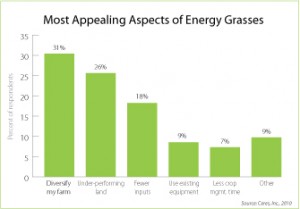America’s growers are ready and willing to produce biomass for advanced biofuels and biopower and have the land to do so according to a survey released by Ceres, Inc. The survey of U.S. growers showed that 71 percent of respondents were very interested or interested in growing dedicated energy crops. In addition, 77 percent of the respondents said they had underutilized land on which they could grow energy grasses like miscanthus, switchgrass or sorghum.
This survey comes on the tail of a recent announcement by the USDA regarding the final rules for the Biomass Crop Assistance Program (BCAP). The program pays eligible growers a incentive to grow biomass crops for use for biopower or to create biofuels.
 Ceres is counting on the growth of biomass for bioenergy and most recently announced that they have developed the first salt tolerant crop, switchgrass. This is a huge advancement especially for agricultural areas that have ceased to produce crops due to the high levels of salt in the water supply. Eventually, Ceres will be looking for farmers to grow their proprietary energy crops.
Ceres is counting on the growth of biomass for bioenergy and most recently announced that they have developed the first salt tolerant crop, switchgrass. This is a huge advancement especially for agricultural areas that have ceased to produce crops due to the high levels of salt in the water supply. Eventually, Ceres will be looking for farmers to grow their proprietary energy crops.
One of the main reasons survey respondents had for growing energy crops was the ability to diversify their current operations. Other reasons given were better use of marginal land and spending less time, money and resources on crop management. In addition, 70 percent of respondents were open to engaging in long-term contracts and 48 percent said they would anticipate putting at least half of their acreage in long-term contracts.
“This is one of the areas where we were interested in learning more about, since reliable feedstock supplies will be critical for new bioenergy facilities to obtain project financing,” said Gary Koppenjan who directs communications and product marketing for Ceres. “What constitutes a long-term contract will likely be an area for discussion, but it appears the suppliers and users are on the same page.”
This non-scientific survey was completed during the summer of 2010 and was skewed to growers in the Southeast United States since that is an area particularly suited to grow energy crops.







 A
A 




